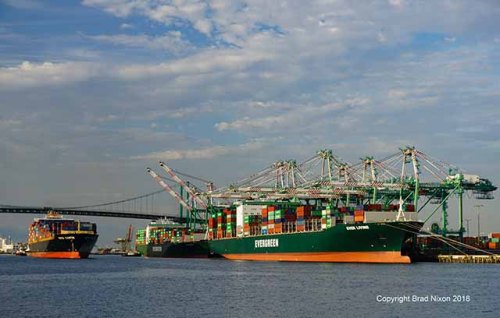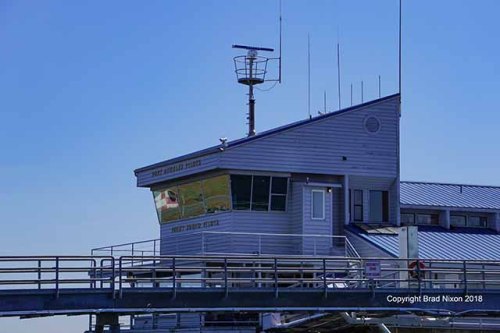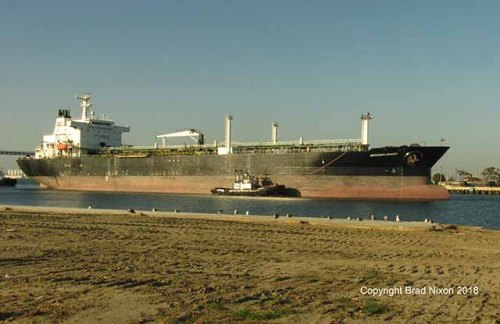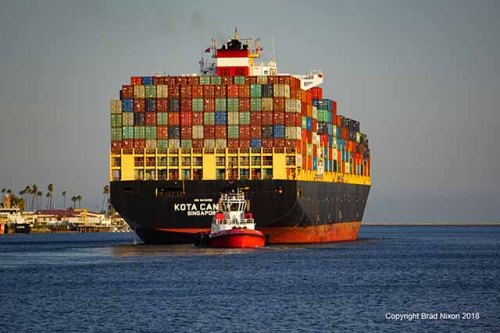In a recent post about my visit to Port Angeles, Washington, I included a photograph of a Pilot boat.
An attractive, official-looking craft. Just what does a pilot boat do? I’m glad you asked.
To answer, first, we need a harbor with some significant commercial activity. For this example, I’ll use a harbor for which I have more photos than Port Angeles: Los Angeles, California.

Moving in and out of busy harbors is marine traffic of many varieties. Our focus will be on large, oceangoing ships, on the scale of the ones in the photo above.
Piloting a vessel of that size is a specialized discipline requiring a great deal of training and expertise. Most of the ship’s time is spent getting from harbor A to harbor B across open ocean, safely, on time, with ship, crew and cargo intact. Perhaps there are moments when commanding a vessel weighing more than 70,000 tons is relatively straightforward, but there are a thousand adjunct matters relating to everything from basic navigation to managing crew schedules or dealing with maintenance issues, not to mention weather or contrary traffic.
Then, the ship reaches port, or more confined waters in a bay or inlet or even a river that lead to a port.
There, local navigation, currents, channels, signals and even language for communicating with other watercraft and facilities become an issue. How does the captain of ship from another country deal with the myriad unique complexities of each port the ship visits? Every port has specific rules, and arrivals and departures of marine traffic are tightly controlled, similar to air traffic control around airports.
Consider this photo of the petroleum tanker Mississippi Voyager in the main channel of the Port of Los Angeles.
L.A.’s main channel is a quarter mile wide, but the 283 meter-long Voyager itself is 32 meters (100 feet) across, not to mention the tugboat beside it. There’s no room in the channel for it to pass a ship coming in the opposite direction. Nothing moves in the port until it’s cleared by the port’s traffic manager. There are exacting protocols for arrival, docking and how the ship’s passage from ocean to port to channel to pier progresses.
The Voyager is accompanied by at least two tugboats (one out of sight, aft). Are the tugs guiding the ship and following directions from the port manager? Nope. There’s an official L.A. port pilot up on that control deck. He or she is temporarily in charge of the Voyager. It’s that pilot’s responsibility to manage the transit of huge craft like Voyager through the port. That practice is common in ports worldwide.
For inbound ships, the pilot is carried out to the ship before it starts into the port, and remains in command until the boat’s moored at its berth. That’s the reason we saw that pilot boat in Port Angeles harbor: to get pilots to incoming or off outgoing commercial craft passing through the Strait of Juan de Fuca to and from the Puget Sound region.

Puget Sound Pilots are responsible for guiding ships to and from ports across an enormous area, and they’re coordinated from an office in Seattle, near Pike’s Place Market. But they may be called to pilot ships bound for or leaving not only Seattle, but Tacoma, Everett or any number of other Puget Sound ports. That Pilot station at Port Angeles is the point at which pilots join incoming ships or disembark from departing ones.
Here’s the Strait seen from the station’s position, looking across the 20 miles of water to Vancouver Island, British Columbia, Canada.

Incoming ships from the Pacific Ocean slow to between 8 and 10 knots near Port Angeles out in the Strait of Juan de Fuca. The pilot boat carries the pilot out to meet the vessel. Once alongside, the pilot boards the ship by climbing a rope ladder — known as a Jacob’s Ladder — up the side of the ship. That’s right. Take a look at the Voyager or the container ships in the previous photo. Yep, part of the job is climbing up to the deck while the ship is moving.
For ships leaving Puget Sound for the ocean, the pilot disembarks the same way, off Port Angeles, and the pilot boat ferries him or her back to the station.
Onboard Operations
As you can imagine, pilots don’t physically grab the tiller and operate the vessels. The ship’s own captain and crew keep doing their jobs. The pilot serves as an expert navigation and communications guide and has ultimate authority. Here is how the Puget Sound Pilots website describes the work:
The process begins when the pilot gets a call to report to a vessel, usually within a few hours of the ship’s departure or arrival. The pilot gathers pertinent information about the ship and its destination from the Puget Sound Pilots’ computer database, checks tides and currents, and plans all aspects of the trip.
The pilot is in charge of the navigation of the ship and directs the actions of the crew and support vessels [i.e. tugboats, etc.] until the ship safely reaches its destination.
During transit, the pilot conducts the ship’s progress, directs the vessel’s route around any impediments, communicates with other marine traffic and the Coast Guard and monitors the vessel’s navigation and communication equipment.
Note that practices can vary in different ports. But if you’re visiting a harbor and see a big commercial vessel making way, there’s probably a harbor pilot aboard. And they climbed that Jacob’s Ladder!
For a brief description of a day in the life of a Puget Sound Pilot, I encourage you to click on the link for the Peninsula Daily News, below. The work requires not only skill and training, but extremely sharp judgment and decision-making ability and an acumen for command.
Photographed this very evening, there goes the Kota Cantik, 300 meters long, 76,000 tons, loaded with containers, leaving the Port of L.A. en route to Oakland, California.
Pilot’s aboard until she clears Angel’s Gate, the mouth of the harbor.
© Brad Nixon 2018. Quotation and other facts collected from the Puget Sound Pilots website, www.pspilots.org, July 31, 2018. Additional information courtesy Peninsula Daily News (Port Angeles, Washington) article dated April 1, 2018 at this link, retrieved July 31, 2018.




Such a great, well-written description of a complex and fascinating world. The anchorage for ships inbound to the Port of Houston lies not so very far off the Galveston jetties, and the comings and goings of the pilot boats always is good entertainment. I’ve not been out there for a while, and a security perimeter may have been established, but it used to be possible to sail closely enough to the ships to watch the pilot boarding.
One of our pilots, Lou Vest, once allowed me to use a couple of his photos in a blog entry. He’s a fabulous photographer, and I think you’d enjoy his “Harbor Life and Piloting” series. There are some time lapse videos of his ships traversing the Houston Ship Channel that are unbelievable.
All of the galleries are worth browsing, although I usually gravitate to those concerned with the ships.
LikeLiked by 1 person
By: shoreacres on August 1, 2018
at 5:11 am
Yikes, what excellent photography on Mr. Vest’s pages. Thank you. It helped to be a total layman when writing about the pilot profession. There’s such a wealth of things to know, if I were any better informed, I’d be overwhelmed with detail. Different for every ship, every port, on any given day.
LikeLike
By: Brad Nixon on August 1, 2018
at 7:32 am
Fascinating post. Being landlocked in Indiana the shipping industry is a whole new animal to me.
LikeLike
By: feistyfroggy on August 1, 2018
at 12:11 pm
As it was for me, moving to a coastal city after more than 4 decades in southern Ohio! Endlessly fascinating. On the other hand, the typical port town resident doesn’t know 3 things about what it’s like to live in the Midwest, starting with the issue of weather!
LikeLiked by 1 person
By: Brad Nixon on August 1, 2018
at 12:18 pm
That must have been culture shock!
What took you to your coastal city?
LikeLike
By: feistyfroggy on August 3, 2018
at 2:18 pm
A person. One you’ve met in this blog: The Counselor.
LikeLiked by 1 person
By: Brad Nixon on August 3, 2018
at 3:18 pm
Of course! It’s always a woman! 😉
LikeLiked by 1 person
By: feistyfroggy on August 6, 2018
at 9:25 am
Interesting pictures of the ships. I live on the St Lawrence Seaway, and we have huge lakers coming up the river, but they are not as big as today’s cargo ships. Montreal has a very interesting port.
LikeLike
By: shawnthompsonart on August 2, 2018
at 7:37 pm
I’d like to see it. Just as fascinating, regardless of scale. Thanks
LikeLike
By: Brad Nixon on August 2, 2018
at 8:17 pm
[…] I wrote more about port pilots at this link. […]
LikeLike
By: Life in the Supply Chain: At the Port | Under Western Skies on November 18, 2021
at 12:09 am